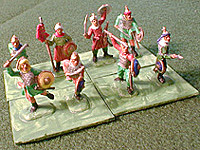 Historical Background: In 1095 AD Pope Urban II called
for a crusade to bring the Holy Land under Christian control,
declaring, “God wills it!” Four years later the crusaders
captured Jerusalem and massacred the inhabitants following a bloody
siege. The crusaders carved out several small kingdoms in the
Middle East centered on powerful castles and fortified cities.
Historical Background: In 1095 AD Pope Urban II called
for a crusade to bring the Holy Land under Christian control,
declaring, “God wills it!” Four years later the crusaders
captured Jerusalem and massacred the inhabitants following a bloody
siege. The crusaders carved out several small kingdoms in the
Middle East centered on powerful castles and fortified cities.
In 1170 AD a new, powerful leader rose to lead the Muslim counterattack. For a while Saladin, as he was known in the West, maintained an uneasy peace with the crusaders. However a series of provocations by the crusaders broke the truce and finally forced his hand. He gathered a large army and laid siege to Tiberias. The Crusaders went for the bait and marched to the rescue. Their line of march took them across a desert where the heavily armored knights suffered terribly in the summer heat. Saladin sent soldiers to harass them during the march, slowing their advance to a crawl. The army was dying of thirst when they approached Lake Tiberias only to find Saladin’s army blocking their path.
In the battle that followed the crusader army was destroyed. Raymond of Tripoli was the only commander to escape, the other the crusader leaders were killed or captured. Saladin’s forces also capture a treasured holy relic – the “True Cross.” The crusader kingdoms could not survive the loss of so many soldiers. Saladin was able to follow up this victory by capturing many lightly defended castles and cities, including Jerusalem. This led to more crusades. The famous third crusade pitted Richard the Lionhearted against Saladin, but the Battle of Hattin had permanently turn the momentum against the crusaders.
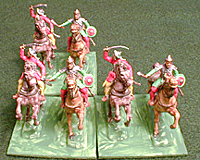 Battle 1:
Battle 1:
Muslims were eager for battle and immediately
launched charges with their light cavalry. The Bedouins on the
left wing were particularly aggressive. They followed this with
a barrage of arrows that darkened the sky and inflicted many casualties.
It soon became clear that a static defense was hopeless, so the
crusaders sent their cavalry out to the flanks to attempt a breakout.
Saladin saw this and he led an all out attack on the weakened
center while ordering his reserves to support the flanks. As the
center buckled the knights found their escape routes blocked.
Only the Knights Templar were about to slip out of the trap, although
the Grand Master Templar and all the crusader commanders were
captured.
Battle 2: Early in this battle the powerful Templars were
able to break through the Muslim lines and threatened to turn
the flank. On the other side of the battle things didn’t
go as well for the crusaders. Raymond of Tripoli was captured,
demoralizing the army. In the center al-Afdal, Saladin’s
son, led an effective attack that broke through the crusader lines
in several places. The knights fell back to defend King Guy of
Jerusalem and the True Cross. The Bedouin light cavalry, seemed
to be everywhere, and they moved to contain the rampaging Templars.
The attack in the center finally succeeded in capturing the True
Cross but at a high cost – al-Sadfal was killed by his own
men in a tragic case of mistaken identity. Suddenly it was every
man for himself as the crusader commanders desperately tried to
escape. After a spirited pursuit King Guy was captured. Only the
Grand Master Templar was able to ride to safety but as he left
the battlefield he was challenged by Taqi al-Din. The arrogant
Grand Master accepted the challenge and was killed in personal
combat with Saladin’s lieutenant. The rout was complete.
Rules
The Miniatures:
The figures used were 1/72-scale plastics mounted two per stand, a mix from several sets. Italeri makes a set of Saracen Warriors (#6010) that includes some useful infantry and cavalry figures. Unfortunately the set also includes a lot of camelry, which weren't present at the battle of Hattin. I needed more cavalry, so I also used some Mongols from the Italeri (#6020) and Zvezda (#8003) sets. The Zvedva Mongols include some useful foot archers. Italeri's "The Knights" set (#6009) includes a nice selection of crusader infantry and cavalry, including crossbowmen. Figures from Revell's English Foot Knights and French Knights provided the rest of the figures I needed. All units were six stands in size - 3 stands in the front rank, three in the rear rank.
|
Saracens (Ayyubids): Saladin (Commander in Chief) Taqi al-Din Kukburi al-Afdal no-name commander |
Crusaders: King Guy of Jerusalem (Commander in Chief) Raymond of Tripoli Balion of Ibelin Reynald de Chatillon Gerard, Grand Master of Templars |
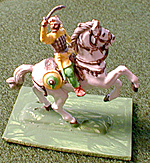 The Board:
The Board:
A 7.5 X 5 foot table was used. The terrain was flat except for the hills know as the Horns of Hattin.
Deployment:
The crusaders deploy in a box on one side of the board. The King's Tent containing the True Cross should be behind their lines. King Guy of Jerusalem must start next to his tent. The Crusaders should have the infantry and crossbowmen in front, with gaps in their lines for the mounted knights to charge through. The Saracens deploy on the other side of the board.
Sequence of Play:
-
1. Saracens Move
2. Saracens Shoot
3. Crusaders Move
4. Crusaders Shoot
5. Charge into Melee
6. Melee
7. Light Cavalry retreat from Melee
Movement:
All infanry move and charge 6", cavalry move and charge 12".
Shooting:
All the Saracen cavalry units, except the Bedouins, have bows and may shoot. The only foot units with missile fire weapons are the Saracen foot archers and Crusader crossbowmen. Roll 1D6 for each stand in range (up to 12"). Every 6 is a hit and one enemy stand is removed. If any part of a unit is in range the entire unit may fire. Units that are engaged in melee may not fire, and may not be targeted.
Charge into Melee:
Both sides may charge into melee. This is the only way to get into hand-to-hand fighting. Foot units may charge up to 6", cavalry may charge 12". Units may only charge if they can reach an enemy unit.
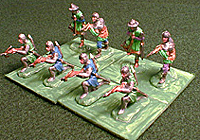 Melee:
Melee:
Each side rolls 1D6 for each stand in the fight. The Close Combat table shows the number needed to score hits. Remove one enemy stand for every hit . Both sides roll simultaneously. If both units still have stands left they remain engaged and fight again next turn.
Light Cavalry Retreat From Melee:
A Saracen light cavalry unit may decide to retreat after melee. This is a free 12" move backwards.
Dying of Thirst:
The Crusaders are dying of thirst. They always roll one less die in melee. For example, a six stand Crusader unit would roll only five dice in melee, not six. This doesn't affect the crossbowmen when they fire their crossbows during the shooting phase.
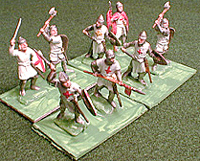 Higher Ground:
Higher Ground:
A unit has an advantage in melee if it is fighting on higher ground than its opponent. A unit in such a position gets to roll one extra die in melee.
Moving Between Infantry:
It was a standard tactic of the period for the cavalry to move through gaps between infantry, charge, then retire behind them to recover. A mounted unit may move between friendly infantry units if there is a gap at least one stand wide between them. This rule can not be used to move between enemy units, or during the charge phase.
The True Cross:
The Crusaders brought along a holy relic to inspire them. The Cross is located in King Guy's tent behind the Crusader lines (you can fold some paper into a tent shape to represent this on the battlefield). Crusader units get to roll two extra dice in melee if any part of the unit is within 6" of the True Cross. This benefit is lost if the Saracens capture the Cross. This occurs if the Saracens reach the tent with a charge and there are no Crusader units in contact with the tent. King Guy of Jerusalem must remain with 6" of the True Cross until it is captured.
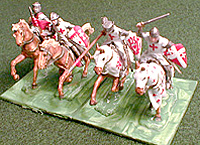 Last Stand:
Last Stand:
If a unit is reduced to one stand this last stand is removed immediately.
Generals:
Generals may not be targeted individually if they are attached to a unit. If they are attached to a unit they count as an extra stand in melee (but not shooting). If the unit they are attached to loses stands in melee roll 1D6. If the roll is a 6 then the General is eliminated. If the general is charged while alone he may be eliminated just like any other stand.
Victory Conditions:
The Saracens are trying to destroy the Crusader army. They win if they eliminate all the mounted knights and all the Crusader commanders and capture King Guy's tent (don't tell them it contains the True Cross). The Crusaders win if they can eliminate Saladin or keep possession of the True Cross. This is very difficult. If the True Cross is captured, or the battle seems lost, give them a new objective: escape. A Crusader commander or mounted knight unit escapes if it can get off the Saracen side of the board.
Resources
A search of the Internet, and Magweb.com (www.magweb.com), turned up several useful resources for wargaming Hattin.
- "The Horns of Hattin" by David Tschanz, Cry Havoc # 17
- "The Templars and the Battle of Hattin" by Stephen Dafoe, Saga #68
- "Hattin, July 4, 1187: DBM Scenario", Ottawa Miniatures Gamers, http://www.orignaux.net/scenarios/scenarios.htm
- Hattin 1187, Saladin's Greatest Victory by David Nicolle, Osprey Campaign #19
|
|
|
Map
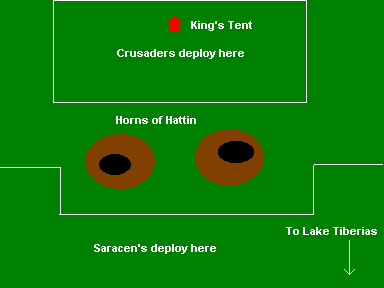
Back to Table of Contents -- Junior General Report #1
Back to Junior General Report List of Issues
Back to MagWeb.com Magazine List
© Copyright 2002 by Matt Fritz.
This article appears in MagWeb.com (Magazine Web) on the Internet World Wide Web. Other articles covering military history and related topics are available at http://www.magweb.com